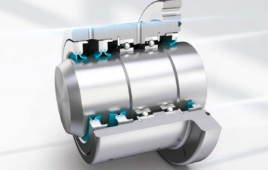Even though today most of the electricity transmission lines are alternating current ones, in some cases direct current lines are also used.And researchers are becoming aware that in some cases direct current lines are more suitable than alternating current ones.
In this area, the GISEL research group of the Department of Electrical Engineering of the UPV/EHU-University of the Basque Country has been working to improve the technology needed for this conversion.The aim has been that this transmission should be done in a more straightforward, smoother and consequently less expensive way.
Electricity is normally transmitted by means of alternating current, but it is not the only way and not always the best one.In some cases, high voltage direct current (HVDC) is used. In Spain, for example, there is only one direct current line, the one that connects mainland Spain with the Balearic Islands; all the remaining ones transmit electricity by means of alternating current.
In fact, “direct current continues to be highly suitable for underwater and underground lines,” asserted Marene Larruskain, one of the engineers in the UPV/EHU’s GISEL group. Furthermore “less investment is needed to build direct current lines, and there are fewer losses in electricity transmission. “However, as most of the lines in the power grid are alternating current ones, converters are needed to change the type of electricity transmission, and they are very costly.”That is why direct current lines are appropriate beyond a certain length,” specified Larruskain.
And this is in fact the use that is made of high voltage direct current lines, to transmit electricity over very long distances; indeed, the longest lines that exist are direct current ones. “There are facilities worldwide thattransmit direct current electricity.The typical examples are the transmission lines of large hydraulic power stations: the Itaipu power station in South America, the Three Gorges power station in China, etc.
Bearing in mind that right now most of the transmission of electricity is done by means of alternating current lines, “our aim is in no way to replace these lines by direct current ones. Our proposal is based on using direct current as a solution in cases where there are problems with the alternating current lines,” explained Larruskain.
Renewable energies could could an example of this.Renewable energies are produced in a very irregular way; the wind, for example, could blow very strongly at some moments and very lightly in others. And the output may not coincide with moments of peak energy consumption.”One way of solving the problem caused by this situation for the electricity supply could be to connect the farms or parks of various countries where renewables are produced. That way, if at one moment one region has a high consumption of energy but is not producing renewable energy, its demand could be metby using renewable energy which is being produced somewhere else,” explained the researcher. As there is a global grid, the variability in production of renewables could be balanced. The UPV/EHU’s GISEL group is proposing that these global grids should be direct current ones.
The aim, to assist transmission
The GISEL group is working to improve the energy exchange converters between direct current lines and alternating current ones.Specifically, they are working on new technology for converters known as VSCs (Voltage Source Converters).Compared with conventional technology, “the VSC has many advantages; among others, it is easier to control the power that is transmitted, and that is very important on wind farms, for example. At the same time, given the fact that direct current has great economic advantages in underwater lines, it is very appropriate for them.”
However, VSC technology has a number of drawbacks: firstly, its capacity to transmit energy is lower, the energy losses are greater and it does not respond well when problems arise. For example, if there is a short circuit, the system has problems. That is why “we’re working to minimize those problems,” explained the researcher.
Secondly, the researchers want to make use of the advantages of both means of transmitting electricity to be able to address growing power consumption. And it is a fact that “even though more and more energy is being produced to meet the demand, problems may arise when it comes to transmitting that energy. It is not always possible to incorporate the surplus energy produced into the already existing lines owing to their limits. In these cases, the use of direct current could solve the problem of the alternating current lines already installed, because, among other things, the HVDC lines can transmit more electrical power,” explained Larruskain.
The GISEL research group has studied how to make the features of the alternating current and direct current lines compatible. The electricity lines of alternating current are three-phase. For example, the number of conductors are three, or multiples of that number. On the other hand, HVDC lines have two poles: a positive one and a negative one. “How are we going to divide two poles into three conductors?” wondered Larruskain. If we use one pole for each phase, one of the conductors of the original line will remain free and part of the power will be lost. That is why a line and a half of alternating current corresponds to each pole of direct current. Even though it looks impossible, there are various ways of making this distribution.
“In the future HVDC grids are expected to coexist with alternating current grids, which are in the majority nowadays.Transmitting direct current via the currently existing lines could be a first step towards building HVDC grids,” explained the UPV/EHU engineer.
Filed Under: Industrial automation




